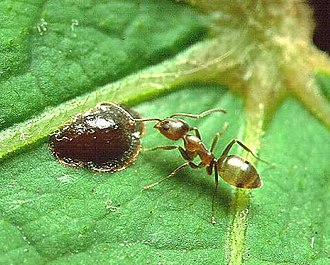I recently read Deborah M. Gordon’s Ant Encounters and thought I’d summarize some thoughts about it. Gordon is a Professor of Biology at Stanford. The book pulls together several decades of research (hers and others’) on the behavior and ecology of ants. In it, Gordon makes nuanced claims about the importance of communication and interaction for distributed collective behavior in clear, non-technical language. Many of the findings should inspire people (like me) interested in understanding the organization of collective behavior in humans.
Gordon argues that ant behavior and colony dynamics encompass a complex system driven by patterns of interactions, information exchange, and environmental influences. She contrasts this with more deterministic accounts of ants prevalent in earlier scientific literature and popular culture. Gordon emphasizes how ants operate by behavioral heuristics and information processing rather than a fixed set of rules or genetically encoded traits.

Consider the division of labor within an ant colony. The prevailing (wrong) view depicts ants born into a pre-specified, genetically determined “caste” which has a clearly-defined task within a hierarchically structured colony. Following this story, the Queen of the colony births out larva who grow into task-specialized sterile adults. Individuals within each caste supposedly possess physical traits that support their specialization as foragers, trash removers, larva-tenders, patrollers, or whatever. Each individual supposedly pursues their specialized task tirelessly until death.
It turns out that this account reflects a mixture of reasonable misinterpretation and fantastical thinking. First off, Gordon notes, ants change tasks within their life course. Today’s larva-tender may be tomorrow’s forager. These changes do not entail biological changes within each ant (although there seems to be evidence that ants do tend to adopt specific tasks at specific stages of their lives within a colony), but instead reflect responses to interactions with other members of the colony and external forces shaping those interactions. In a younger, less populous colony, ants may change tasks in response to immediate needs and threats that arise suddenly. In larger, more mature colonies where things are less likely to change suddenly, many ants may have more stable activities. Some ants in large colonies even literally sit around doing nothing because the information they receive from their nest-mates indicates that the colonies needs are being met. None of this is fixed by genetic encoding or hierarchical commands.
Second, Gordon shows how ants respond probabilistically to local stimuli. Individual ants, it turns out, act a lot like heuristic distributed sensors or nodes in a communications network—each with some likelihood of changing its behavior depending on the feedback it receives from its environment. They are not automatons with deterministic programming to pursue a single-minded course of action.
Third, Gordon shows how colonies as a whole change in reaction to their environments and collective interactions. If one colony finds itself in proximity to another, the individuals within it may alter how much collective effort is dedicated to specific tasks depending on the species, size, and temperament of its neighbors. Individual ants respond to the number of nest-mates and neighbors they encounter. If their last ten encounters were with foragers from their home nest returning with food to feed the larval brood, they may continue to go about their business uninterrupted. As the portion of recent interactions includes outsiders or nest-mates responding frantically to an unwelcome intruder of some sort, the probability rises that the next ant will change its behavior in response (maybe to start running around in a panic or bite an intruder).
Through many examples, Gordon conveys how patterns of collective ant behavior emerge and adapt to local circumstances without a centralized coordination mechanism or hierarchy of control. She describes this almost entirely without recourse to the jargon of complexity theory or complex systems research.
A concrete, measured, and example-driven account of how actually existing complex systems work is maybe the most impressive achievement of the book. Many texts discuss complexity in human and ecological systems, but none that I have read do so with the clarity of Ant Encounters. While I should read more books on these topics, more people in my little corner of the research world should read Gordon’s work too.
Ant Encounters ultimately left me excited to pursue some of the potential extensions and connections between Gordon’s work and research on human social systems and organizations. For example, I’d love to follow up on her comment that higher interaction frequency is associated with colony growth or survival (I currently forget which). Would such a finding hold up in the context of human organizations? If so, what would it look like and mean in the context of building effective peer production systems? Gordon has also written elsewhere about some of the potential connections between ant behavior, human organization, communication protocols. Recent findings from Gordon and her collaborators show how ants follow a set of behavior protocols very similar to those encoded in the TCP specification (apparently, she likes to refer to this idea as “the Anternet“). I’m eager to read more of the scientific publications from Gordon and her collaborators to understand these ideas more deeply and to see how well they travel when applied to a species I know a little bit more about.
Discover more from Community Data Science Collective
Subscribe to get the latest posts sent to your email.
